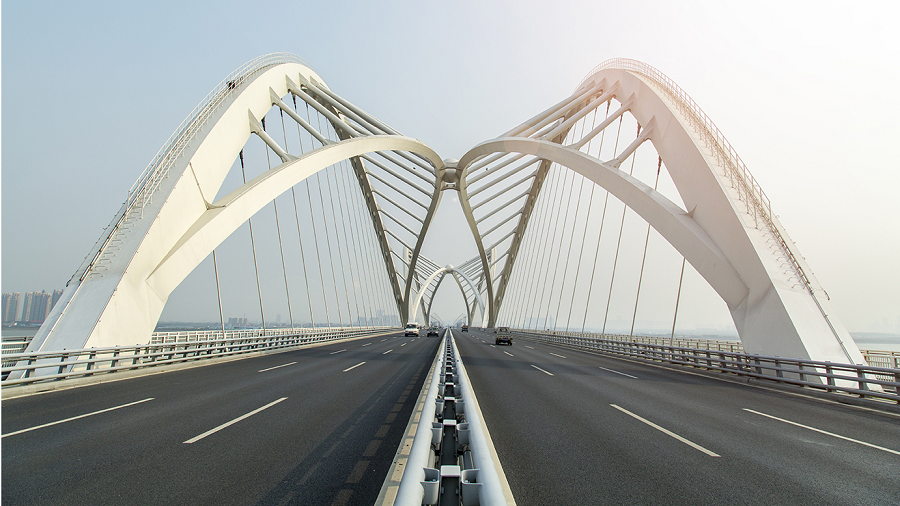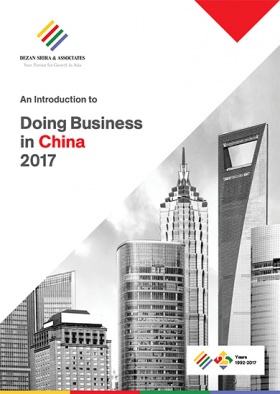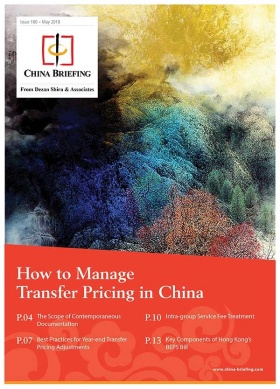The Yangtze River Delta Integration Plan
By Mark Preen

Shanghai is usually considered China’s most international and economically significant city. In 2017, it had a gross domestic product (GDP) of RMB 3.01 trillion (US$475 billion) – the highest of all cities in China. The Yangtze River Delta, which centers around Shanghai, is an important international gateway and one of the major engines of China’s economy.
In addition to the municipality of Shanghai, the Yangtze River Delta region is traditionally made up of the provinces of Jiangsu and Zhejiang, and more recently also includes the province of Anhui. The whole region covers 211,770 km2 – more than twice the size of South Korea.
Currently, the Yangtze River Delta is China’s richest region per capita, and in 2016 generated a GDP of RMB 17.72 trillion (US$2.76 trillion) – about 20 percent of national GDP. It is responsible for one-third of China’s imports and exports, and has a population of about 150 million people – 11 percent of the country’s total.
The region is set to continue to play a significant role in China’s economy with its transformation into a world-class city cluster.
In 2010, China’s State Council approved a plan that aims to make the Yangtze River Delta region even more competitive so that it is transformed into a world-class city cluster by 2030. To be successful, the region will have to compete against China’s other regional clusters – the Pearl River Delta and Beijing-Tianjin-Hebei region – and overcome an array of integration challenges.
Integration plans
The Yangtze River Delta region was one of the first regions in China to develop and open-up, and is now known for its competitive and innovative industries. For example, the automobile industry has a good foundation in the region, with Shanghai and all three surrounding provinces contributing to its success.
However, areas in the region also have their own strengths in specific areas. Shanghai is a logistics center and mainland China’s financial center, while Zhejiang and Jiangsu provinces have strong manufacturing bases.
These two provinces are well known for their large number of industrial parks, in cities such as Hangzhou and Suzhou, and the huge quantities of foreign direct investment that they attract. Anhui province has an abundance of natural resources, and is a large provider of energy and coal to eastern China.

For the Yangtze River Delta project to be successful, provinces and cities in the region will need to cooperate with each other and focus on their own comparative advantages so that duplication is avoided, areas complement each other, and synergies are maximized.
To help achieve this, in June 2018 authorities from Shanghai, Zhejiang, Jiangsu, and Anhui agreed a three-year action plan (2018-2020), which will provide a strategic roadmap and includes nearly a dozen collaborative projects to increase the region’s competitiveness on a global scale.
In tandem with this, a RMB 100 billion (US$16 billion) fund, The Yangtze River Delta Collaborative Advantage Fund, was launched in Shanghai. RMB 10 billion (US$1.6 billion) of this fund will be made available in the first phase and will be available for “hard technology” projects that will help to integrate the region’s industries.
As well as focusing on its current strengths, the region must utilize its innovative abilities to develop new comparative advantages in the modern service industry and the advanced manufacturing industry. The region will therefore play a leading role in China’s next stage of economic development – moving up the value chain – by developing the priority industries outlined in the country’s ‘Made in China 2025’ industrial strategy.
Priority industries that the Yangtze River Delta will be active in developing include marine and high-tech ships, new energy vehicles, power equipment, advanced rail, medical technology, aviation and aerospace, and ICT.
Further to this, Shanghai tourism authorities recently announced that they aim to make the whole Yangtze River Delta region a world-famous tourist destination. Cities and tourist attractions in the region will be encouraged to integrate with schemes including a cross-region car rental system and a single ticket covering admissions in the region.
As the region is keen to attract the foreign technology to develop these priority industries, there are opportunities in the region for foreign investors. The region’s current industrial parks and two free trade zones (FTZs) will assist the region in developing these priority industries and attracting foreign investment.
![]() RELATED: Investing in Inland China: Assessing Chongqing’s Industrial Zones
RELATED: Investing in Inland China: Assessing Chongqing’s Industrial Zones
Infrastructure development
Physical infrastructure will play an important role in integrating Shanghai and the other 25 cities in the cluster, as well as connecting the region with the rest of the world.
The Yangtze River Delta’s infrastructure is already relatively highly developed. The region is home to nine international airports and is connected by a dense network of high speed railway networks, including the Shanghai to Nanjing intercity line, which also links Suzhou, Wuxi, Changzhou, and Zhenjiang.
The Shanghai and Ningbo ports are two of the busiest ports in the world, ranked first and fourth respectively in the 2016 container traffic world port rankings. These two ports are also partly linked by an expansive 35 km bridge across the Hangzhou Bay, which is the 12th longest bridge in the world.
However, even with strong existing infrastructure, the government has plans to further develop the region. The Hangzhou-Taizhou Expressway is expected to be completed by 2019 and a 331-kilometre high speed railway line between Hangzhou and Wenzhou is expected to be complete by 2021. The latter of these is expected to cut the journey time between the two cities from three hours to 55 minutes.
Further, the 12.5 metre Yangtze River deep-water channel will be extended up to Nanjing, which will ensure that 50,000 tonne vessels can reach Nanjing directly and strengthen the city’s role as a logistics centre.
The Yangtze River Economic Belt
By itself, the Yangtze River Delta cluster is an ambitious project. However, what is even more remarkable is that the Chinese government plans to extend these ambitions by exploiting the full length of the Yangtze River. The government aims to achieve this through the grand ‘Golden Waterway’ Yangtze River Economic Belt project, which was first issued in 2016.
The Yangtze River covers more than 2 million km2; and approximately 40 percent of the country’s population and about 45 percent of its GDP are situated along the river. Two other clusters along the river, the Middle Yangtze cluster (focused on Wuhan) and the Yangtze Upper Reaches cluster (focused on Chongqing) are important pivots along the river and will link up with the Yangtze River Delta to strengthen the ‘backbone’ of China’s economy.
The project aims to open up the central and western regions of China to the eastern coast, and subsequently to the rest of the world. Businesses located on the coast can also move westward where they can take advantage of lower wages and the financial incentives offered under China’s ‘Go West’ strategy.
Industrial capacity will gradually be transferred from the Yangtze River Delta region to inland regions, allowing these regions to move from lower-end and heavy polluting industries to higher-end and more environmentally friendly industries. President Xi Jinping and other leading figures have reiterated that the project should focus on environmental protection over rapid growth by moving from old engines to new engines of growth.
Further to the above, the Yangtze River Economic Belt will link the Yangtze River Delta region to Chongqing, which is near to where the New Silk Road Belt section of another ambitious initiative starts: the Belt and Road Initiative.
The Yangtze River Economic Belt project has the potential to help reduce the disparities between China’s booming coastal regions and the poorer inner regions. There are already signs of these disparities being reduced, as the ratio between the provinces with the highest and lowest GDP per capita fell from 4.3 times in 2012 to 3.6 times in 2016
![]() Pre-Investment, Market Entry Strategy Advisory Services from Dezan Shira & Associates
Pre-Investment, Market Entry Strategy Advisory Services from Dezan Shira & Associates
Obstacles and opportunities
Integration is key to the success of any cluster. For the Yangtze River Delta region, there is optimism in this respect given that the Yangtze River Delta region already has highly developed infrastructure and is successful in key industries.
However, integration will still be challenging due to its scale and ambition, and challenges in overcoming the tradition of provincial and prefectural governments competing for projects and investment opportunities.
These challenges are even greater for the wider Yangtze River Economic Belt project given that its scale and ambitions are even grander. The Belt includes three clusters, two municipalities (Shanghai and Chongqing), and nine provinces, but lacks developed and interconnected infrastructure, including inefficient railway and highway linkages.
However, with these challenges also come opportunities. Foreign investors can, for example, increase their participation in infrastructure development and the operation of projects in the areas where infrastructure is weak.
Plans for the Yangtze River Delta cluster are clearly ambitious and face an array of challenges. If the Yangtze River Economic Belt is also considered, then these ambitions and challenges are even greater than those faced by China’s other two aspiring world-class city clusters – the Pearl River Delta and the Beijing-Tianjin-Hebei region.
However, Shanghai and the provinces of Zhejiang and Jiangsu provide a strong base that can be used to support not only the development of the Yangtze River Delta cluster, but also the wider development of the Yangtze River Economic Belt. And foreign businesses in the region can benefit from the initiative even if they are not directly involved in its development.
Lorena Miera, International Business Advisory Associate at Dezan Shira & Associates’ Shanghai office, remarked, “Greater regulatory and transport integration between different jurisdictions will improve the region’s business environment.”
Miera continued, “This can be helpful, for example, when a foreign company has their headquarters in Shanghai but deals with a factory in another nearby city.”
Although it seems more likely that the ambitions of the cluster rather than the Belt will be realized, at least in the short-term, it is worth noting that the two projects and the degree of their success will be dependent upon each other. If both of the projects are successful, then the region will be quite unique in terms of its economic scale and influence.
About Us
China Briefing is published by Asia Briefing, a subsidiary of Dezan Shira & Associates. We produce material for foreign investors throughout Asia, including ASEAN, India, Indonesia, Russia, the Silk Road, and Vietnam. For editorial matters please contact us here, and for a complimentary subscription to our products, please click here.
Dezan Shira & Associates is a full service practice in China, providing business intelligence, due diligence, legal, tax, accounting, IT, HR, payroll, and advisory services throughout the China and Asian region. For assistance with China business issues or investments into China, please contact us at china@dezshira.com or visit us at www.dezshira.com
- Previous Article The New Foreign Permanent Resident ID Card in China
- Next Article Shanghai’s Green Manufacturing Sector: New Initiatives Announced





